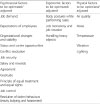1. Rezagholi M, Bantekas A. Making economic social decisions for improving occupational health – a predictive cost-benefit analysis. Occup Med Health Aff. 2015; 3:6. DOI:
10.4172/2329-6879.1000225.

2. Rezagholi M. Differential socio-economic effects of work environmental risk factors. Journal of Health & Medical Economics. 2016; 2(2:9):1–8.
3. Sehgal S. Relationship between work environment and productivity. Int J Eng Res Appl. 2012; 2:1992–1995.
4. Taiwo AS. The influence of work environment on workers' productivity: a case of selected oil and gas industry in Lagos, Nigeria. Afr. J Bus Manag. 2010; 4:299–307.
5. Hameed A, Amjad S. Impact of office design on employees' productivity: a case study of banking organizations of Abbottabad. Pakistan J Pub Affairs Admin Manag. 2009; 3:1–13.
6. Leblebici D. Impact of workplace quality on employee's productivity: case study of a bank in Turkey. Journal of Business, Economics & Finance. 2012; 1:38–49.
7. Akbari J, Dehghan H, Azmoon H, Forouharmajd F. Relationship between lighting and noise levels and productivity of the occupants in automotive assembly industry. J Environ Public Health. 2013;2013:527078. .
8. Tompa E, Dolinschi R, Oliveira C, Amick BC 3rd, Irvin E. A systematic review of workplace ergonomic interventions with economic analyses. J Occup Rehabil 2010;20:220–234.
10. Goggins RW, Spielholz P, Nothstein GL. Estimating the effectiveness of ergonomics interventions through case studies: implications for predictive cost-benefit analysis. J Saf Res. 2008; 39:339–344. DOI:
10.1016/j.jsr.2007.12.006.

11. Karlsson ML, Björklund C, Jenson I. The effects of psychosocial work factors on production loss, and the mediating effect of employee health. J Occup Environ Med. 2010; 52(3):310–317. DOI:
10.1097/JOM.0b013e3181d1cda2. PMID:
20190652.

12. Reineholm C. Psychosocial work conditions and aspects of health [dissertation]. 2013. Linköping: Linköping University Medical Dissertations.
13. Reineholm C, Gustavsson M, Ekberg K. Evaluation of job stress models for predicting health at work. Work. 2011; 40:229–237. PMID:
21876277.

14. European Agency for Safety and Health at Work. Motivation for employers to carry out work place health promotion 2012; 10.2802/50267.
15. Aust B, Ducki A. Comprehensive health promotion interventions at the workplace: experiences with health circles in Germany. J Occup Health Psychol. 2004; 9(3):258–270. DOI:
10.1037/1076-8998.9.3.258. PMID:
15279520.

16. Beermann B, Kuhn K, Kompier M. Germany: ‘Reduction of stress by health circles' in Kompier M, Cooper C. Preventing stress, improving productivity: European case studies in the workplace. London; Routledge 1999: 222–241.
17. Rezagholi M. Economic decisions on proposed work environmental studies – a theory for cost and value of information. Science Journal of Public Health. 2016; 4:11–19. DOI:
10.11648/j.sjph.20160401.12.

18. Tsutsumi A, Kawakami N. A review of empirical studies on the model of effort – reward imbalance at work: reducing occupational stress by implementing a new theory. Soc Sci Med. 2004; 59:2335–2359. DOI:
10.1016/j.socscimed.2004.03.030. PMID:
15450708.
19. Rhoades L, Eisenberger R. Perceived organizational support: a review of the literature. J Appl Psychol. 2002; 87:698–714. DOI:
10.1037/0021-9010.87.4.698. PMID:
12184574.

20. Ismail AR, MRA R, Makhbul ZM, Meier C. Optimization of environmental factors: a study at Malaysian automotive industry. Eur J Sci Res. 2009; 27:500–509.
21. de Jonge J, Bosma H, Peter R, Siegrist J. Job strain, effort-reward imbalance and employee well-being: a large-scale cross-sectional study. Soc Sci Med. 2000; 50:1317–1327. DOI:
10.1016/S0277-9536(99)00388-3. PMID:
10728851.

22. van der Doef M, Maes S. The job demand-control(−support) model and physical health outcomes: a review of the strain and buffer hypotheses. Psychol Health. 1998; 13:909–936. DOI:
10.1080/08870449808407440.

23. Rissén D, Melin B, Sandsjö L, Dohns I, Lundberg U. Psychophysiological stress reactions, trapezius muscle activity, and neck and shoulder pain among female cashiers before and after introduction of job rotation. Work & Stress. 2002; 16(2):127–137. DOI:
10.1080/02678370210141530.

24. Oparanma AO, Nwaeke LI. Impact of job rotation on organizational performance. British Journal of Economics, Management & Trade. 2015; 7(3):183–187. DOI:
10.9734/BJEMT/2015/12051.

25. Mohsan F, Musarrat Nawaz M, Sarfraz Khan M. Impact of job rotation on employee motivation, commitment and job involvement in banking sector of Pakistan. African Journal of Business Management. 2012; 6(24):7114–7119.

26. van Vegchel N, de Jonge J, Bakker AB, Schaufeli WB. Testing global and specific indicators of rewards in the effort – reward imbalance model: does it make any difference? European Journal of Work and Organizational Psychology. 2002; 11:403–421. DOI:
10.1080/13594320244000265.
27. van Vegchel N, de Jonge J, Bosma H, Schaufeli W. Reviewing the effort – reward imbalance model: drawing up the balance of 45 empirical studies. Soc Sci Med. 2005; 60:1117–1131. DOI:
10.1016/j.socscimed.2004.06.043. PMID:
15589679.
28. Li J, Yang W, Siegrist J, Cho S. Effort-reward imbalance at work and job dissatisfaction in Chinese healthcare workers: a validation study. Int Arch Occup Environ Health. 2005; 78:198–204. DOI:
10.1007/s00420-004-0581-7. PMID:
15838712.

29. Ajila C, Abiola A. Influence Of rewards on workers performance in an organisation. J Soc Sci. 2004; 8:7–12.
30. Soragaon B, Hiregoudar NL, Mallur SB. Development of a conceptual model for the measurement of overall worker effectiveness (OWE) in discrete manufacturing SMES. International Journal of Engineering and Innovative Technology (IJEIT). 2012; 2:366–372.
31. Abdullah H. Major Challenges to the effective management of human resource training and development activities. The journal of international. Soc Res. 2009; 2:11–25.
32. Norsworthy JR, Zaballa CA. Worker attitudes, worker behavior, and productivity in the US automobile industry 1959-1976. Ind Labor Relat Rev. 1985; 38:544–553.

33. Fletcher SR, Baines TS Harrison DK. An investigation of production workers' performance variations and the potential impact of attitudes. Int J Adv Manuf Technol. 2008; 35:1113–1123. DOI:
10.1007/s00170-006-0793-y.







 PDF
PDF Citation
Citation Print
Print



 XML Download
XML Download